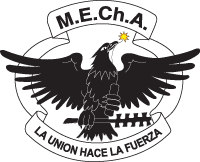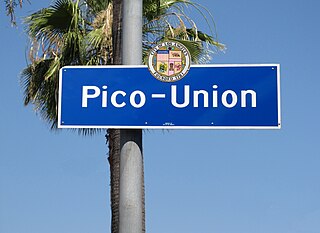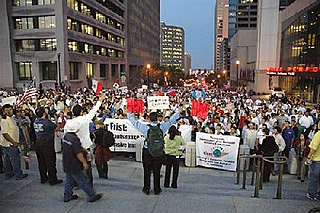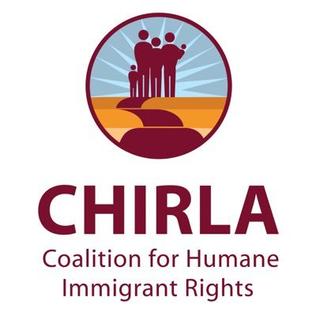
M.E.Ch.A. is a US-based organization that seeks to promote Chicano unity and empowerment through political action. The acronym of the organization's name is the Chicano word mecha, which is the Chicano pronunciation of the English word match and therefore symbolic of a fire or spark; mecha in Spanish means fuse or wick. The motto of MEChA is 'La Union Hace La Fuerza'.

California Proposition 187 was a 1994 ballot initiative to establish a state-run citizenship screening system and prohibit illegal immigrants from using non-emergency health care, public education, and other services in the State of California. Voters passed the proposed law at a referendum on November 8, 1994. The law was challenged in a legal suit the day after its passage, and found unconstitutional by a federal district court on November 11. In 1999, Governor Gray Davis halted state appeals of this ruling.

Pico-Union is a neighborhood in Central Los Angeles, California. The name "Pico-Union" refers to the neighborhood that surrounds the intersection of Pico Boulevard and Union Avenue. Located immediately west of Downtown Los Angeles, it is home to over 40,000 residents.

KLAX-FM is an American commercial radio station located in East Los Angeles, California, broadcasting to the Greater Los Angeles area. It is owned by Spanish Broadcasting System (SBS). KLAX-FM airs a regional Mexican music format branded as "La Raza". The station has studios in Los Angeles, and its transmitter is based in Glendale.

Walkout is a 2006 HBO film based on a true story of the 1968 East L.A. walkouts, also referred to as the Chicano blowouts. It premiered March 18, 2006 on HBO. Starring Alexa Vega, Efren Ramirez and Michael Peña, the film was directed by Edward James Olmos. Moctezuma Esparza, one of the real-life students who was involved in the walkouts, was the film's executive producer.
Justice for Janitors (JfJ) is a social movement organization that fights for the rights of janitors across the US and Canada. It was started on June 15, 1990, in response to the low wages and minimal health-care coverage that janitors received. Justice for Janitors includes more than 225,000 janitors in at least 29 cities in the United States and at least four cities in Canada. Members fight for better wages, better conditions, improved healthcare, and full-time opportunities.

James A. Garfield High School is a year-round public high school founded in 1925 in East Los Angeles, an unincorporated section of Los Angeles County, California. At Garfield, 38% of students participate in advanced placement programs. Approximately 93% of the student population comes from disadvantaged backgrounds with limited financial or social opportunities. The school maintains a comprehensive minority admission policy with a 100% minority population.
The Border Protection, Anti-terrorism, and Illegal Immigration Control Act of 2005 was a bill in the 109th United States Congress. It was passed by the United States House of Representatives on December 16, 2005, by a vote of 239 to 182, but did not pass the Senate. It was also known as the "Sensenbrenner Bill," for its sponsor in the House of Representatives, Wisconsin Republican Jim Sensenbrenner. The bill was the catalyst for the 2006 U.S. immigration reform protests and was the first piece of legislation passed by a house of Congress in the United States illegal immigration debate. Development and the effect of the bill was featured in "The Senate Speaks", Story 11 in How Democracy Works Now: Twelve Stories a documentary series from filmmaking team Shari Robertson and Michael Camerini.

In 2006–2007, millions of people participated in protests over a proposed change to U.S. immigration policy. These large scale mobilizations are widely seen as a historic turning point in Latino politics, especially Latino immigrant civic participation and political influence, as noted in a range of scholarly publications in this field. The protests began in response to proposed legislation known as H.R. 4437, which would raise penalties for illegal immigration and classify illegal individuals and anyone who helped them enter or remain in the US as felons. As part of the wider immigration debate, most of the protests not only sought a rejection of this bill, but also a comprehensive reform of the country's immigration laws that included a path to citizenship for all illegal immigrants.

The East Los Angeles Walkouts or Chicano Blowouts were a series of 1968 protests by Chicano students against unequal conditions in Los Angeles Unified School District high schools. The first walkout occurred on March 5, 1968. The students who organized and carried out the protests were primarily concerned with the quality of their education. This movement, which involved thousands of students in the Los Angeles area, was identified as "the first major mass protest against racism undertaken by Mexican-Americans in the history of the United States".

The Great American Boycott, also called the Day Without an Immigrant, was a one-day boycott of United States schools and businesses by immigrants in the United States which took place on May 1, 2006.

Salvador B. Castro was a Mexican-American educator and activist. He was most well known for his role in the 1968 East Los Angeles high school walkouts, a series of protests against unequal conditions in Los Angeles Unified School District (LAUSD) schools. After he retired from teaching, he continued to lecture about his experiences and the importance of education, especially for Mexican Americans.

Carlos Montes is a nationally respected leader in the Chicano, immigrant rights, and anti-war movements. He was a co-founder of the Brown Berets, a Chicano working class youth organization in the United States in the late 1960s and 1970s. The Brown Berets were inspired by and often compared to the Black Panther Party. Montes was one of the leaders of the Chicano Blowouts, a series of walkouts of East Los Angeles high schools to protest against racism and inequality in Los Angeles-area high schools. He is portrayed by Fidel Gomez in the 2006 HBO movie Walkout.
Nativo Lopez-Vigil was an American political leader and immigrant rights activist in Southern California. Lopez was a national president of the Mexican American Political Association and the national director of the Hermandad Mexicana Latinoamericana, a community service and advocacy organization for Mexican and Latin American immigrants throughout the United States.

Theodore Roosevelt High School is an educational institution located in the Boyle Heights area of Los Angeles, California named for the 26th president of the United States.

The Coalition for Humane Immigrant Rights, also known as CHIRLA, is a Los Angeles county-based organization focusing on immigrant rights. While the organization did evolve from a local level, it is now recognized at a national level. The Coalition for Humane Immigrant Rights of Los Angeles organizes and serves individuals, institutions and coalitions to build power, transform public opinion, and change policies to achieve full human, civil and labor rights. The Coalition for Humane Immigrant Rights of Los Angeles also has aided in passing new laws and policies to benefit the immigrant community regardless of documented status.

Historically there has been a population of Chinese Americans in Los Angeles and the Los Angeles Metropolitan Area. As of 2010, there were 393,488 Chinese Americans in Los Angeles County, 4.0% of the county's population, and 66,782 Chinese Americans in the city of Los Angeles.

The following is a timeline of the protests against Donald Trump, the former president of the United States of America, businessman, and television personality.

Day Without Immigrants was a protest and boycott that took place on February 16, 2017, to demonstrate the importance of immigration, and to protest President Donald Trump's plans to build a border wall and to potentially deport millions of undocumented immigrants. The strike called for immigrants not to go to work, to avoid spending money, and keep children home from school. People took part to show the importance of immigrants to the economy and also to protest possible racial profiling of U.S. citizens by immigration enforcement. The strike was planned on social media. People first started talking about the strike after the Women's March, and as the idea gained momentum, important people in the restaurant industry helped boost exposure.
Stand for the Second was a student-led demonstration in support of the United States Second Amendment held on May 2, 2018. The demonstration was in response to the March for Our Lives protest held on March 24, 2018.
















